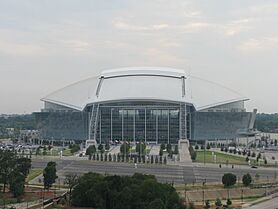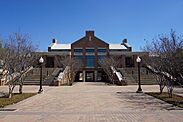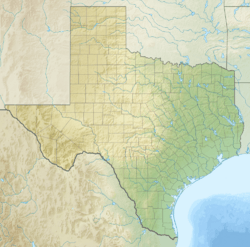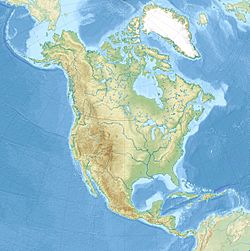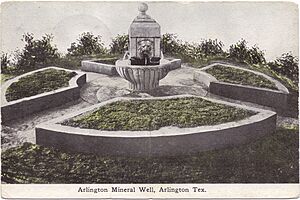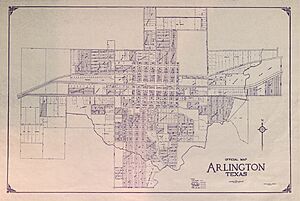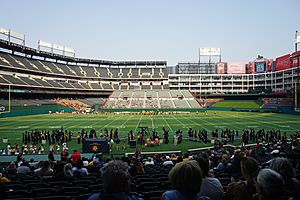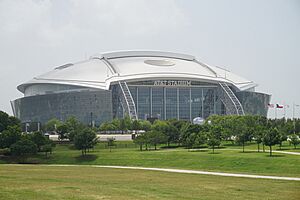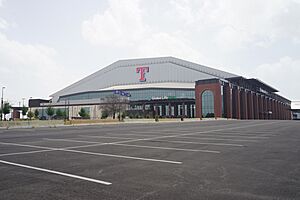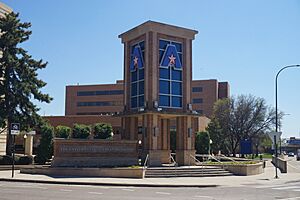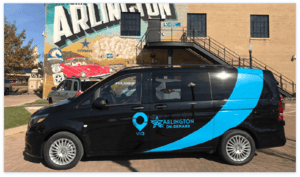Arlington, Texas facts for kids
Quick facts for kids
Arlington
|
|||
|---|---|---|---|
|
Oil Derrick Tower at Six Flags Over Texas
Arlington Hall at UT Arlington
Globe Life Field
Arlington Chamber of Commerce
|
|||
|
|||
| Motto(s):
The American Dream City
|
|||
| Country | |||
| State | |||
| County | Tarrant | ||
| Founded | 1876 | ||
| Named for | Arlington House | ||
| Government | |||
| • Type | Council–Manager | ||
| Area | |||
| • Total | 99.44 sq mi (257.54 km2) | ||
| • Land | 95.84 sq mi (248.22 km2) | ||
| • Water | 3.60 sq mi (9.32 km2) | ||
| Elevation | 604 ft (184 m) | ||
| Population
(2020)
|
|||
| • Total | 394,266 | ||
| • Rank | 50th in the United States 7th in Texas |
||
| • Density | 4,113.79/sq mi (1,588.37/km2) | ||
| Demonym(s) | Arlingtonian | ||
| Time zone | UTC−6 (CST) | ||
| • Summer (DST) | UTC−5 (CDT) | ||
| ZIP Codes |
76001-76007, 76010-76018, 76094, 76096
|
||
| Area codes | 682,817, 214, 469, 945, 972 | ||
| FIPS code | 48-04000 | ||
| GNIS feature ID | 2409731 | ||
Arlington is a big city in Tarrant County, Texas, United States. It's part of the huge Dallas–Fort Worth area. In 2020, about 398,431 people lived here. This makes Arlington the second-largest city in Tarrant County. It's also the seventh-largest city in Texas!
Arlington is home to many cool places. You can find the University of Texas at Arlington here. Big companies like General Motors and Texas Health Resources also have locations in Arlington.
Sports fans will love Arlington! It hosts the Texas Rangers baseball team at Globe Life Field. The Dallas Cowboys football team plays at AT&T Stadium. You can also find the Dallas Wings basketball team at College Park Center.
For fun, there are awesome theme parks like Six Flags Over Texas and Hurricane Harbor. Arlington is also known as the world headquarters for bowling. This is because the United States Bowling Congress and the International Bowling Museum are located here.
Contents
- The History of Arlington
- Where is Arlington? (Geography)
- Who Lives in Arlington? (Demographics)
- Arlington's Economy
- Fun Things to Do in Arlington (Culture)
- Sports in Arlington
- Learning in Arlington (Education)
- Getting Around Arlington (Transportation)
- Notable People from Arlington
- Images for kids
- See also
The History of Arlington
How Arlington Started and Grew
People first settled in the Arlington area in the 1840s. Farmers were drawn to the rich soil. By the late 1800s, many businesses related to farming were set up.
Arlington was officially founded in 1876. It was built along the Texas and Pacific Railway. The city got its name from Arlington House in Virginia. Arlington quickly grew as a center for cotton farming. It became an official city on April 21, 1884. By 1910, Arlington had water, electricity, natural gas, and phone services. It also had its own public school system.
From 1892 to 1951, a special mineral well in downtown Arlington was a popular spot. People visited the town just for its water. The well was a meeting point for important discussions, like women's right to vote. Today, the well is covered over.
Exciting Times in the 1920s and 1930s
The 1920s and 1930s were busy times in Arlington. A tea room called "Top O' Hill Terrace" opened. It served travelers between Dallas and Fort Worth. Later, this place secretly became a casino and a speakeasy. Historians call it "Vegas before Vegas." It had secret tunnels and rooms to hide illegal gambling from the police.
By 1925, Arlington had about 3,031 people. In 1929, a horse-racing track called Arlington Downs was built. Even though gambling was illegal, people still placed bets. In 1933, horse racing bets became legal in Texas. The track made a lot of money. But in 1937, the state changed the laws again, and the track was sold.
Arlington During and After World War II
In the 1940s, Arlington Downs was used for rodeos and other events. Top O' Hill Terrace kept its secrets until 1947. Then, a famous Texas Ranger shut down the gambling operation.
World War II brought many families to Arlington looking for jobs. Before the war, the city had over 4,000 people. The war helped Texas become a big manufacturing state. Arlington was perfectly located between Dallas and Fort Worth, which were major aerospace centers.
In 1956, Arlington Baptist University bought the Top O' Hill Terrace property. The old tunnels and buildings are still there. In 1958, Arlington Downs was completely torn down. Only a concrete water trough and a historical marker remain.
Big factories started coming to Arlington in 1954. A General Motors car assembly plant opened. This led to a huge population boom between 1950 and 1990. Arlington became a "boomburb," a very fast-growing suburb. The population grew from 7,692 in 1950 to 261,721 in 1990.
In 1961, Six Flags Over Texas opened. In 1972, the Washington Senators baseball team moved to Arlington. They became the Texas Rangers. In 2009, the Dallas Cowboys football team also started playing in Arlington at the new AT&T Stadium.
In 1996, a sad event led to the creation of the Amber Alert system. This system helps find missing children quickly. In 2019, Arlington was chosen to be the home of the $150 million National Medal of Honor Museum. It is expected to open in 2024.
Where is Arlington? (Geography)
Arlington covers about 99.7 square miles (257.54 square kilometers). Most of this is land, with some water. The city is about 12 miles east of downtown Fort Worth. It's also about 20 miles west of downtown Dallas.
Johnson Creek and the Trinity River flow through Arlington. Arlington shares borders with Kennedale, Grand Prairie, Mansfield, and Fort Worth. It also surrounds smaller towns like Dalworthington Gardens and Pantego.
Arlington's Climate
Arlington has a humid subtropical climate. This means it has hot, humid summers and mild to cool winters.
- The hottest temperature ever recorded was 113°F (45°C) in 1980.
- The coldest temperature ever recorded was -8°F (-22°C) in 1899.
- May usually has the most rain.
- Severe weather, like thunderstorms, often happens in April and May.
- Arlington is in "Tornado Alley," an area known for tornadoes.
- Snow is rare in winter, and some years have no snow at all.
| Climate data for Arlington Six Flags, Texas (1991–2020 normals, extremes 1893–1894, 1991–2020) | |||||||||||||
|---|---|---|---|---|---|---|---|---|---|---|---|---|---|
| Month | Jan | Feb | Mar | Apr | May | Jun | Jul | Aug | Sep | Oct | Nov | Dec | Year |
| Record high °F (°C) | 83 (28) |
96 (36) |
94 (34) |
101 (38) |
101 (38) |
105 (41) |
110 (43) |
110 (43) |
111 (44) |
97 (36) |
89 (32) |
88 (31) |
111 (44) |
| Mean daily maximum °F (°C) | 55.0 (12.8) |
59.4 (15.2) |
67.1 (19.5) |
74.4 (23.6) |
81.6 (27.6) |
90.0 (32.2) |
94.4 (34.7) |
94.5 (34.7) |
87.6 (30.9) |
77.0 (25.0) |
65.0 (18.3) |
57.0 (13.9) |
75.2 (24.0) |
| Daily mean °F (°C) | 44.7 (7.1) |
48.6 (9.2) |
56.6 (13.7) |
64.0 (17.8) |
72.4 (22.4) |
80.8 (27.1) |
84.8 (29.3) |
84.4 (29.1) |
77.4 (25.2) |
66.2 (19.0) |
55.0 (12.8) |
46.8 (8.2) |
65.1 (18.4) |
| Mean daily minimum °F (°C) | 34.3 (1.3) |
37.9 (3.3) |
46.0 (7.8) |
53.7 (12.1) |
63.2 (17.3) |
71.6 (22.0) |
75.1 (23.9) |
74.2 (23.4) |
67.3 (19.6) |
55.4 (13.0) |
45.1 (7.3) |
36.6 (2.6) |
55.0 (12.8) |
| Record low °F (°C) | 3 (−16) |
9 (−13) |
15 (−9) |
31 (−1) |
39 (4) |
51 (11) |
57 (14) |
52 (11) |
40 (4) |
19 (−7) |
20 (−7) |
10 (−12) |
3 (−16) |
| Average precipitation inches (mm) | 2.67 (68) |
3.24 (82) |
3.51 (89) |
3.34 (85) |
4.66 (118) |
3.78 (96) |
2.46 (62) |
2.40 (61) |
3.45 (88) |
4.82 (122) |
2.76 (70) |
3.00 (76) |
40.09 (1,018) |
| Average snowfall inches (cm) | 0.1 (0.25) |
0.4 (1.0) |
0.0 (0.0) |
0.0 (0.0) |
0.0 (0.0) |
0.0 (0.0) |
0.0 (0.0) |
0.0 (0.0) |
0.0 (0.0) |
0.0 (0.0) |
0.0 (0.0) |
0.3 (0.76) |
0.8 (2.0) |
| Average precipitation days (≥ 0.01 in) | 5.4 | 6.5 | 7.6 | 6.3 | 8.2 | 7.5 | 4.7 | 4.8 | 5.8 | 6.0 | 5.6 | 5.5 | 73.9 |
| Average snowy days (≥ 0.1 in) | 0.2 | 0.2 | 0.0 | 0.0 | 0.0 | 0.0 | 0.0 | 0.0 | 0.0 | 0.0 | 0.0 | 0.1 | 0.5 |
| Source: NOAA | |||||||||||||
The 2012 Tornado Event
On April 3, 2012, a strong tornado hit eastern Kennedale and moved into Arlington. It was an EF2 tornado, meaning it had strong winds of about 135 mph. The tornado was about 150 yards wide and traveled for 4.6 miles.
This tornado damaged many businesses. It tore off a large part of the roof of the Green Oaks Nursing and Rehabilitation Center. Eighteen homes were destroyed, and 291 others were damaged. Eight people were hurt, with one serious injury.
Who Lives in Arlington? (Demographics)
| Historical population | |||
|---|---|---|---|
| Census | Pop. | %± | |
| 1880 | 163 | — | |
| 1890 | 664 | 307.4% | |
| 1900 | 1,079 | 62.5% | |
| 1910 | 1,794 | 66.3% | |
| 1920 | 3,031 | 69.0% | |
| 1930 | 3,661 | 20.8% | |
| 1940 | 4,240 | 15.8% | |
| 1950 | 7,692 | 81.4% | |
| 1960 | 44,775 | 482.1% | |
| 1970 | 90,643 | 102.4% | |
| 1980 | 160,113 | 76.6% | |
| 1990 | 261,721 | 63.5% | |
| 2000 | 332,969 | 27.2% | |
| 2010 | 365,438 | 9.8% | |
| 2020 | 394,266 | 7.9% | |
| 2023 (est.) | 398,431 | 9.0% | |
| U.S. Decennial Census 2010–2020 |
|||
| Race / Ethnicity (NH = Non-Hispanic) | Pop 2000 | Pop 2010 | Pop 2020 | % 2000 | % 2010 | % 2020 |
|---|---|---|---|---|---|---|
| White alone (NH) | 198,591 | 164,022 | 137,731 | 59.64% | 44.88% | 34.93% |
| Black or African American alone (NH) | 45,061 | 67,087 | 88,230 | 13.53% | 18.36% | 22.38% |
| Native American or Alaska Native alone (NH) | 1,359 | 1,338 | 1,213 | 0.41% | 0.37% | 0.31% |
| Asian alone (NH) | 19,837 | 24,564 | 30,067 | 5.96% | 6.72% | 7.63% |
| Pacific Islander alone (NH) | 406 | 373 | 429 | 0.12% | 0.10% | 0.11% |
| Other race alone (NH) | 415 | 597 | 1,679 | 0.12% | 0.16% | 0.43% |
| Mixed race or Multiracial (NH) | 6,483 | 7,188 | 13,973 | 1.95% | 1.97% | 3.54% |
| Hispanic or Latino (any race) | 60,817 | 100,269 | 120,944 | 18.27% | 27.44% | 30.68% |
| Total | 332,969 | 365,438 | 394,266 | 100.00% | 100.00% | 100.00% |
In 2020, Arlington had 394,266 people. There were 135,240 households and 93,164 families. In 2010, about 31% of the population was under 20 years old. 30% were between 25 and 44 years old.
The average household income in 2011 was about $50,655. About 20% of Arlington's population lived below the poverty line. This included 28% of people under 18.
Arlington's Economy
Top Employers in the City
Arlington has many job opportunities. Here are the top five employers in the city:
| # | Employer | # of Employees |
|---|---|---|
| 1 | Arlington Independent School District | 9,429 |
| 2 | Texas Health Resources | 6,619 |
| 3 | General Motors | 5,640 |
| 4 | University of Texas at Arlington | 5,600 |
| 5 | Six Flags Over Texas | 3,800 |
Fun Things to Do in Arlington (Culture)
Arts and Entertainment

Arlington is famous for Six Flags Over Texas, a big theme park. Six Flags also has Six Flags Hurricane Harbor, a waterpark.
Arlington is the world headquarters for bowling. It has the United States Bowling Congress and the International Bowling Museum.
For shopping, you can visit the Parks Mall at Arlington. It has many stores, restaurants, and an ice skating rink. The Arlington Highlands is another popular spot for shopping and entertainment. Lincoln Square, near AT&T Stadium, also has stores and restaurants.
Arlington has a large community theater called Theatre Arlington. It puts on live shows all year. The Mainstage Theatre at UT Arlington is another place to see live plays.
The Arlington Museum of Art and the Gallery at UT Arlington are great places to see art. In 2016, the art museum started a project called "The Star of Texas." Artists painted large star sculptures with their ideas of the city. You can still see these stars around town. Downtown Arlington also has cool art murals.
The Planetarium Dome Theater at UT Arlington is one of the biggest in Texas.
The Levitt Pavilion Arlington opened in 2009. It offers 50 free concerts each year in downtown Arlington. You can hear many different types of music there. Texas Hall and AT&T Stadium also host live concerts.
Every July 4th, there's an annual parade through Downtown Arlington. Local schools, businesses, and groups have floats. About 75,000 people watch the parade each year.
Texas Live! is a big entertainment area. It has dining, entertainment, and a hotel. It's right next to the new Globe Life Field. Texas Live! opened in August 2018.
Sports in Arlington
Professional Sports Teams
Arlington is home to the Texas Rangers baseball team. They moved here in 1972. In 1994, they built The Ballpark in Arlington. The Rangers won the 2023 World Series! In 2017, they started building a new stadium, Globe Life Field. This new stadium is now their home.
The Dallas Cowboys football team moved to Arlington in 2009. They play at the huge AT&T Stadium. This stadium has hosted many big events. These include the Super Bowl XLV in 2011 and college basketball championships. The Dallas Cowboys rent the stadium from the City of Arlington.
The Dallas Wings are a women's basketball team. They became the first WNBA team in North Texas in 2015. They play their home games at the College Park Center in Arlington.
The Arlington Renegades are a UFL football team. They started in 2019 and play at Choctaw Stadium.
The North Texas SC soccer team also plays at Choctaw Stadium.
AT&T Stadium will host many matches during the 2026 FIFA World Cup.
College Sports Teams
The UT Arlington Mavericks are the sports teams for The University of Texas at Arlington. They compete in NCAA Division I sports. They play in the Western Athletic Conference.
A new arena called the College Park Center opened in 2012. It hosts basketball and volleyball games. It can seat about 7,000 people.
Arlington Baptist College also has sports teams called the Patriots. They compete in the National Christian College Athletic Association.
Famous Athletes from Arlington
Many famous athletes have come from Arlington.
- Ben Grieve, a baseball player, went to Martin High School.
- Vernon Wells, another baseball player, grew up here.
- Hunter Pence, a baseball player, went to Arlington High School.
- John Lackey, a pitcher, played for UT Arlington.
- Jeremy Wariner won two gold medals in the 2004 Olympics for running.
- Ronnie Coleman, a champion bodybuilder, lives in Arlington.
- Myles Garrett, a football player for the Cleveland Browns, graduated from Martin High School.
Motorsports Events
In 2026, IndyCar will have its first ever Grand Prix of Arlington. This race will take place around AT&T Stadium and Globe Life Field.
Learning in Arlington (Education)
Colleges and Universities
Arlington has several colleges and universities.
Public Colleges
The University of Texas at Arlington (UTA) is one of the largest universities in Texas. It has over 40,000 students. UTA is very important to Arlington's economy. Some of its buildings are among the oldest in the Dallas/Fort Worth area.
The Southeast Campus of Tarrant County College is also in Arlington.
Private Colleges
Arlington Baptist University (ABU) is a private four-year college. It offers different degrees.
A branch of University of Phoenix is in Arlington. Ogle School, a cosmetology school, also has its main campus here.
Schools for Kids (Primary and Secondary)
Arlington's students attend schools in five different school districts:
- Arlington ISD
- Mansfield ISD
- Hurst-Euless-Bedford ISD
- Kennedale ISD
- Fort Worth ISD
School district boundaries don't always follow city limits. So, not all Arlington residents are in Arlington ISD. Also, some students in Arlington ISD don't live in Arlington.
Arlington ISD currently has ten high schools. There are also many private and charter schools in Arlington.
Getting Around Arlington (Transportation)
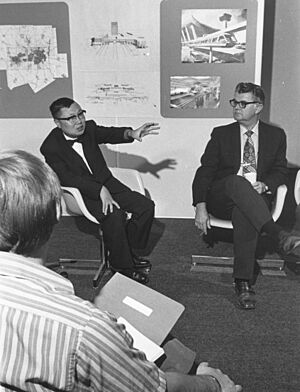
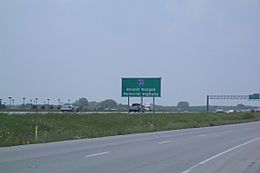
In 1902, the first electric trolley came to Arlington. It connected Dallas, Fort Worth, and Arlington. This service was very popular until 1934. The trolley tracks ran along what is now Abram Street.
The Arlington Municipal Airport (GKY) is in Arlington. It's a public airport owned by the city. It helps take pressure off bigger airports like Dallas/Fort Worth International Airport.
For many years, Arlington was the largest U.S. city without public transportation. Voters rejected plans for it three times. However, things have changed!
In 2017, Arlington launched Milo, an autonomous vehicle shuttle service. These self-driving electric shuttles help people get to major events. They connect parking areas to the stadiums.
Arlington also offers Via Arlington. This is a public, on-demand shared transportation service. Riders can ask for a pickup from a six-passenger van. This service covers key places in Arlington. It also connects to the Trinity Railway Express (TRE) CentrePort Station. From there, you can take a train to Fort Worth or Dallas. This service expanded to cover the whole city in January 2021.
Arlington also works with Via and May Mobility for Arlington RAPID. This service provides on-demand self-driving car rides in Downtown Arlington. It also serves the University of Texas at Arlington campus.
Arlington has a low percentage of households without a car. In 2016, only 3.7% of households didn't have a car. The national average was 8.7%.
Two major highways serve the city: I-20 and I-30. I-20 is also called Ronald Reagan Memorial Highway. I-30 is named Tom Landry Memorial Highway. State Highway 360 runs along the eastern border. It's named after Angus G. Wynne, who founded Six Flags Over Texas. U.S. Highway 287 goes through the southwestern part of the city.
There is also a tollway called The 360 Tollway. It connects Mansfield to Arlington and Grand Prairie. It's also known as the Rosa Parks Memorial Parkway.
The Union Pacific Railroad owns the old Texas and Pacific rail route through Arlington. It mainly serves the General Motors assembly plant. Most of its trains are just passing through.
Notable People from Arlington
Images for kids
See also
 In Spanish: Arlington (Texas) para niños
In Spanish: Arlington (Texas) para niños


